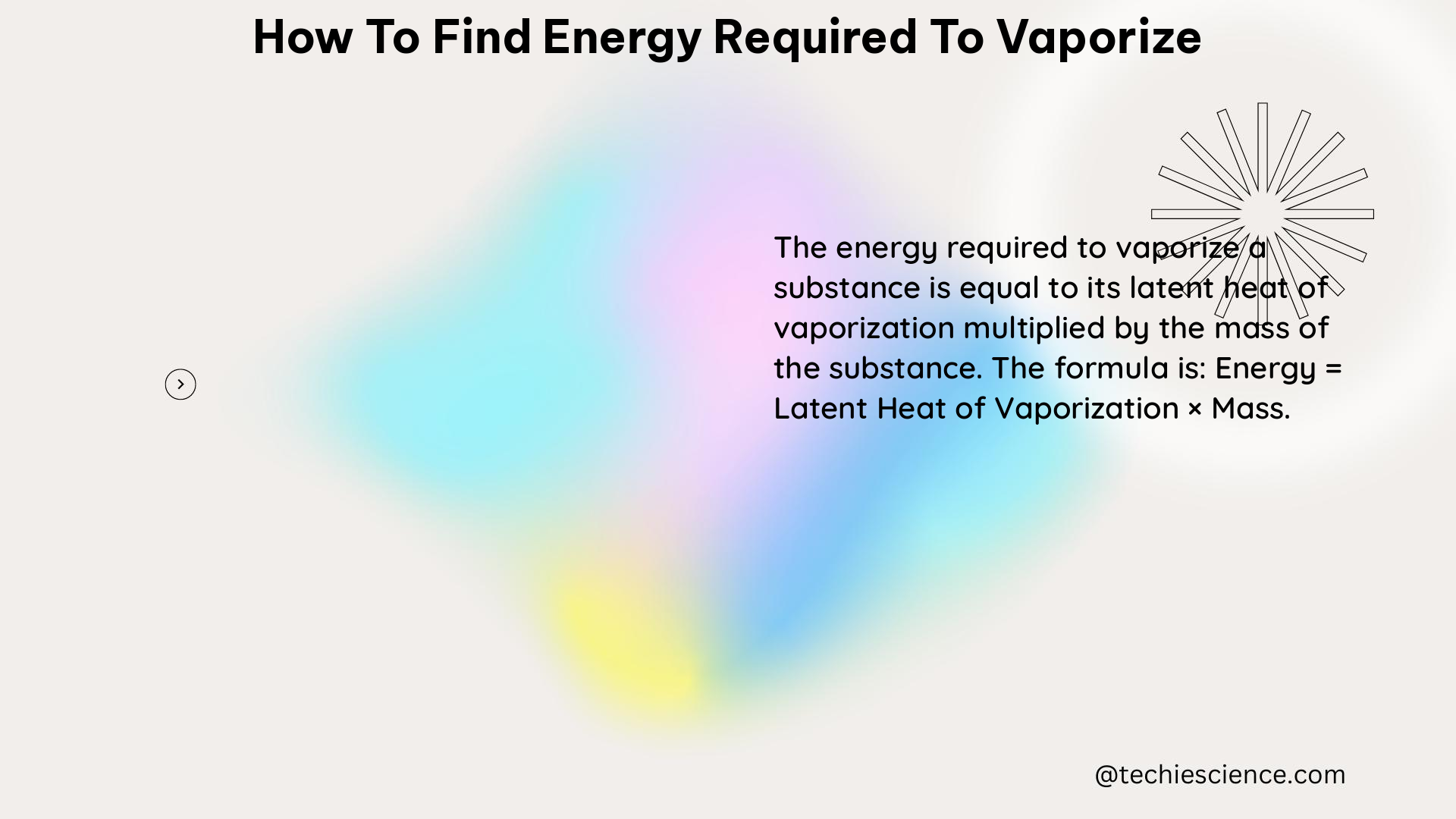The energy required to vaporize a substance is a crucial concept in thermodynamics and phase changes. To determine the energy needed to vaporize a substance, we must consider its heat of vaporization, which is the energy required to convert the substance from its liquid phase to its gas phase at a constant temperature and pressure. This blog post will provide a comprehensive guide on how to calculate the energy required for vaporization, including the necessary formulas, examples, and practical applications.
Understanding Heat of Vaporization
The heat of vaporization, denoted as Lv, is the amount of energy required to convert one unit of a substance from its liquid phase to its gas phase at a constant temperature and pressure. This energy is typically measured in joules per mole (J/mol) or joules per gram (J/g).
The heat of vaporization is a crucial property that varies for different substances. For example, the heat of vaporization for water at 100°C and 1 atm pressure is 40.7 kJ/mol or 2.26 kJ/g. This means that it requires 40.7 kJ of energy to vaporize 1 mol of water or 2.26 kJ to vaporize 1 g of water at these conditions.
Calculating the Energy Required for Vaporization

To find the energy required to vaporize a substance, we can use the following formula:
Q = m × Lv
Where:
– Q is the energy required for vaporization (in joules)
– m is the mass of the substance (in grams)
– Lv is the heat of vaporization (in joules per gram, J/g)
Let’s consider an example to illustrate the calculation:
Example 1: Calculating the Energy Required to Vaporize 1 Liter of Water
Given:
– Mass of 1 liter of water (m) = 1000 g
– Heat of vaporization for water (Lv) = 2.26 kJ/g (or 2260 J/g)
Substituting the values in the formula:
Q = m × Lv
Q = 1000 g × 2.26 kJ/g
Q = 2260 kJ
Therefore, the energy required to vaporize 1 liter of water is approximately 2.26 MJ (2260 kJ).
Raising the Temperature of a Substance
In addition to the energy required for vaporization, we may also need to consider the energy required to raise the temperature of a substance. The energy required to raise the temperature of a substance is given by the formula:
Q = m × c × ΔT
Where:
– Q is the energy required to raise the temperature (in joules)
– m is the mass of the substance (in grams)
– c is the specific heat capacity of the substance (in joules per gram per degree Celsius, J/g°C)
– ΔT is the change in temperature (in degrees Celsius)
Let’s consider another example:
Example 2: Calculating the Energy Required to Raise the Temperature of 1 Liter of Water
Given:
– Mass of 1 liter of water (m) = 1000 g
– Specific heat capacity of water (c) = 4.184 J/g°C
– Temperature change (ΔT) = 100°C – 25°C = 75°C
Substituting the values in the formula:
Q = m × c × ΔT
Q = 1000 g × 4.184 J/g°C × 75°C
Q = 334,700 J ≈ 335 kJ
Therefore, the energy required to raise the temperature of 1 liter of water from 25°C to 100°C is approximately 335 kJ.
Comparison of Energy Requirements
By comparing the energy required for vaporization (2.26 MJ) and the energy required to raise the temperature (335 kJ), we can see that the energy barrier for phase change (vaporization) is significantly higher than the energy required for a temperature change.
This highlights the significant amount of energy needed to overcome the phase change from liquid to gas, which is why boiling water takes a considerable amount of time and energy input.
Additional Considerations
- The heat of vaporization can vary depending on the substance and the temperature and pressure conditions.
- The specific heat capacity can also vary for different substances and may depend on temperature.
- In real-world applications, other factors such as heat transfer efficiency, insulation, and system design can also affect the energy requirements.
Conclusion
Understanding the energy required for vaporization is crucial in various fields, such as chemical engineering, thermodynamics, and energy systems. By using the formulas and examples provided in this blog post, you can accurately calculate the energy needed to vaporize a substance and compare it to the energy required for temperature changes. This knowledge can be applied to optimize processes, design efficient systems, and gain a deeper understanding of phase changes and energy transformations.
References
- Enthalpy of Vaporization – an overview | ScienceDirect Topics: https://www.sciencedirect.com/topics/chemistry/enthalpy-of-vaporization
- Specific Heat – Physics LibreTexts: https://phys.libretexts.org/Bookshelves/University_Physics/Physics_(Boundless)/13%3A_Heat_and_Heat_Transfer/13.2%3A_Specific_Heat
- Energy & Heat – Foundations of Physics – BC Open Textbooks: https://opentextbc.ca/foundationsofphysics/chapter/energy-heat/

The lambdageeks.com Core SME Team is a group of experienced subject matter experts from diverse scientific and technical fields including Physics, Chemistry, Technology,Electronics & Electrical Engineering, Automotive, Mechanical Engineering. Our team collaborates to create high-quality, well-researched articles on a wide range of science and technology topics for the lambdageeks.com website.
All Our Senior SME are having more than 7 Years of experience in the respective fields . They are either Working Industry Professionals or assocaited With different Universities. Refer Our Authors Page to get to know About our Core SMEs.